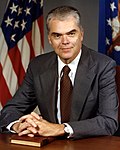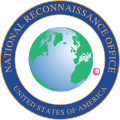Chronological list of National Reconnaissance Office directors
This is a list of directors of the NRO, and the terms in office.
| Photo | Name | Term of Office | Presidential Administration(s) | Significant events |
|---|---|---|---|---|
 | Dr. Richard M. Bissell, Jr. | September 1961 – February 1962 [1] | Kennedy | Co-director with Dr. Charyk |
 | Dr. Joseph V. Charyk | September 6, 1961 – March 1, 1963 | Kennedy | First NRO co-director |
 | Dr. Brockway McMillan | March 1, 1963 – October 1, 1965 | Kennedy/Johnson | |
 | Dr. Alexander H. Flax | October 1, 1965 – March 17, 1969 | Johnson | |
 | Dr. John L. McLucas | March 17, 1969 – December 20, 1973 | Nixon | |
 | Mr. James W. Plummer | December 21, 1973 – June 28, 1976 | Nixon/Ford | |
 | Mr. Thomas C. Reed | August 9, 1976 – April 7, 1977 | Ford/Carter | |
 | Dr. Hans Mark | August 3, 1977 – October 7, 1979 | Carter | |
 | Dr. Robert J. Hermann | October 8, 1979 – August 2, 1981 | Carter/Reagan | |
 | Mr. Edward (Pete) C. Aldridge, Jr. | August 3, 1981 – December 16, 1988 | Reagan | |
 | Mr. Martin C. Faga | September 28, 1989 – March 5, 1993 | Bush/Clinton | Declassification of NRO |
 | Mr. Jeffrey K. Harris | May 19, 1994 – February 26, 1996 | Clinton | Declassification of CORONA/ARGON/LANYARD |
 | Mr. Keith R. Hall | March 28, 1997 – December 13, 2001 | Clinton/Bush | September 11, 2001 attacks |
 | Mr. Peter B. Teets | December 2001 – March 2005 | Bush | |
 | Dr. Donald M. Kerr | July 2005 – October 5, 2007 | Bush | |
 | Mr. Scott F. Large | October 19, 2007 – April 18, 2009 [2] | Bush/Obama | |
 | General Bruce Carlson, USAF (Ret.) | June 12, 2009 – July 20, 2012 [3] | Obama | |
 | Ms. Betty J. Sapp | July 20, 2012 – April 4, 2019 | Obama/Trump | First woman NRO Director |
 | Dr. Christopher Scolese | August 5, 2019 – present | Trump/Biden | First presidentially-appointed and Senate-confirmed NRO Director [4] |











